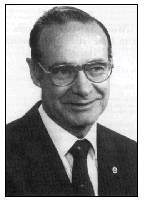
Chemistry International
Vol. 22, No.3, May 2000
2000, Vol. 22
No. 3 (May)
..Chemistry in Slovenia
..News from IUPAC
..Reports from Symposia
..New Projects
..New Books
..Letter to the Editor
..Reports from Commissions
..Provisional Recommendations
..Conference Announcements
..Conferences
Download the May
issue in pdf format.
(932K)
Download the May
cover in pdf format.
(58K)
Chemistry International
Vol. 22, No. 3
May 2000New Books and Publications
New Books from IUPAC
Macromolecular Symposia, Vol. 143: Macromolecules.
Symposium Editor, K. P. Ghiggino; Editor-in-Chief, Hartwig Hocker; Editors, W. Guth, B. Jung, I. Meisel, and S. Spiegel. Published by Wiley-VCH, August 1999, pp. 1—370. ISBN 3-527-29903-3 (ISSN 1022-1360).> View Table of Contents
Volume 143 of Macromolecular Symposia contains plenary and keynote lectures delivered at Macro98 World Polymer Congress, the 37th IUPAC International Symposium on Macromolecules, which was held on the Gold Coast, Queensland, Australia 11—15 July 1998. One thousand and seventy-five delegates attended, plus about 120 accompanying persons. Most delegates were from outside Australia, indeed coming from 45 differ ent countries. The biennial IUPAC World Polymer Congresses provide a special opportunity for scientists to meet each other and to become aware of developments and progress in other countries. From these conferences, future links emerge between individuals and between organizations. The meeting was opened by His Excellency the Governor of Queensland, Major-General Peter Arnison. The Governor noted the international scientific and technical importance of the meeting, and indeed was able to draw on his own background (as former executive director of a company producing products for the mining, agricultural, transport, and local government services) to put the meeting in context. He noted the enormous number of benefits that are conferred on our everyday lives by artificial and natural polymers, in addition to the fascinating scientific challenges they present.
Invited speakers and contributed poster and verbal papers covered literally every aspect of polymer science and technology; there were a total of 1 050 papers presented in all. The program also included various symposia, not least of which was that on Polymer Science and Industry. Indeed, the first speaker after the Governor’s opening, Dr. Peter Chan of Polymer Coating Technologies of Singapore, set the tone of scientific excellence and relevance, when he spoke on scientific challenges arising from new technology demands. Subsequent speakers in this symposium, which extended for two days, addressed scientific, technical, and societal issues.
Other major components of the conference were the O’Donnell Symposium on Radiation Chemistry and Polymers, and the Symposium on Polymer Education. Other symposia were on Characterization; Polymer Synthesis; Polymers for New Technologies; Polymers; the Environment and Health Issues; Structure and Properties; Engineering Polymers; Theory and Modeling of Polymer Systems, Films, Surfaces and Interfaces; Novel Polymers; Polymer Colloids; Rheology and Processing; and Polymer Photophysics and Photochemistry. Each of these symposia was coorganized by an Australian scientist and an overseas scientist. Australia is an old land geologically, but AustralianChemistry International, 2000, Vol. 22, No. 3 83 science is young and vigorous, and Australian polymer scientists welcomed the opportunity to host the most important biennial conference in the field at the forefront of polymer science and technology.
Many components contributed to the success of this conference– especially the excellence of the delegates and the large number and vigor of the younger participants who will be the next scientific generation. An essential ingredient for a successful conference is the willingness of all participants to learn and to interact both inside and outside the lecture rooms. It was for this reason that the venue was chosen at the Gold Coast, where the networking that is vital for world science was nurtured by the pleasant environment. Delegates left the conference with new knowledge and new friends, from which will grow new science.
Prof. Jim O'DonnellThere were a number of special parts to this conference. One was the Young Scientists program, which encouraged interchange among research students and other young scientists from around the world. Another was the Industrial Forum, which focused on the applications of our science. These applications are vital, when financial changes pose a challenge to us all to help wealth creation, in the deepest meaning of the expression, and to improve the quality of life. The nature of our field is such that we can all help make a better world.
This conference came about because of the dedication, vision, energy, organizational skills, and enthusiasm of the late Prof. Jim O’Donnell of the Chemistry School of the University of Queensland, who died tragically of cancer three years before the conference. Jim was a fine polymer scientist and internationalist, a personal friend and mentor to many of the attendees, and one who cared greatly for international issues and for the good of young polymer scientists. The numbers and diversity of overseas delegates, and the high quality and number of the scientific papers at Macro98, are some of Jim’s memorials.
Prof. Robert G. Gilbert, Cochair,
Macro98 World Polymer Congress
President, IUPAC Macromolecular DivisionProf. Donald H. Napper, Cochair,
Macro98 World Polymer Congress
News
and Notices - Organizations and People
- Standing Committees
Divisions
- Projects - Reports
- Publications - Symposia
- AMP - Links
Page last modified 8 May 2000.
Copyright © 1997-2000 International Union of Pure and Applied Chemistry.
Questions or comments about IUPAC, please
contact the Secretariat.
Questions regarding the website, please contact [email protected]

